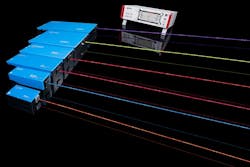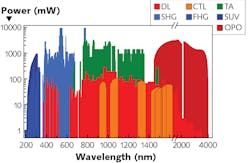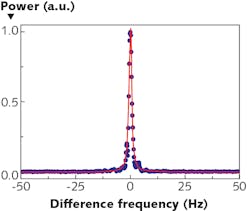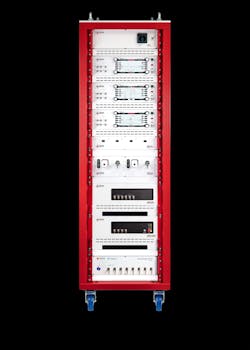STEPHAN RITTER and JÜRGEN STUHLER
When quantum theories were first formulated a century ago, who would have guessed how many technological developments originating from quantum physics shape the way we live and interact today? Whether we work on a computer, use our mobile phones, or get a diagnosis based on magnetic resonance imaging, the understanding of quantum mechanics is the basis for all these technologies.
In photonics, the laser and light-emitting diodes (LEDs) are prime examples, with a current market of more than $12 billion for lasers alone. Now, there are new quantum technologies on the horizon, with applications so exciting that researchers and science writers alike are proclaiming a second quantum revolution.
From basic research to market
Their enthusiasm is shared by governments and companies investing heavily in “quantum 2.0.” The most fragile properties of quantum systems, often perceived as counterintuitive or even spooky, are actually the source of radically new technologies. While the resulting applications are novel, the tools to enable quantum technologies are not. Already, Newton acknowledged what is at the heart of modern science and technology: “If I have seen further, it is by standing on the shoulders of Giants.”
This is particularly true for quantum technologies. As an example, the laser, a product of the first quantum revolution, is an enabling technology for quantum technologies. Its application is by no means limited to purely optical quantum technologies. Lasers are rather found in the majority of quantum setups.
In fact, the laser company TOPTICA Photonics AG (Munich, Germany), which has its origins in laser cooling and spectroscopy of atomic species, is now the major provider of laser systems for all areas of quantum technologies: quantum communication, quantum computing, quantum simulation, quantum metrology, and quantum sensing.
Most obviously, light sources are at the heart of quantum networks, because photons are the natural carriers of quantum states over large distances. They enable applications like quantum key distribution and the future interconnection of quantum computers, but lasers are also essential components in many quantum computers, quantum sensors, and optical clocks. In essence, the incredible control over all degrees of freedom of the light emanating from a laser, often at the quantum limit, is a prime tool to initialize, manipulate, and read out other quantum systems.
Every property of a laser—that is, its wavelength, linewidth, power, polarization, temporal, and spatial beam profile—is an important control parameter in quantum technologies. In quantum communication, this is reflected in the many different encodings for quantum information. The polarization of a single photon can carry a quantum bit (qubit) just as its temporal shape can be in the form of a time-bin qubit.
The timing, frequency, spatial structure, and even orbital angular momentum of single photons can likewise be used to encode quantum information, each with their specific advantages and disadvantages. Some of these degrees of freedom can even be used to go beyond qubits, which live in a two-level system, and encode qudits, a generalization of the qubit to additional dimensions. The phase and amplitude of pulses of light are also employed in quantum communication.
All wavelengths required
The list of quantum systems used in or proposed for quantum technologies is no less varied than the list of quantum applications. This may seem immature compared to the one-species-does-it-all approach of silicon-based classical computer technologies. It reflects, however, the intrinsic interconnections of individual atomic properties like their energy-level structure and the variety of applications.Researchers take advantage of the full diversity provided by nature by employing many different elements of the periodic table, not only in their neutral form, but also as ions, in molecules, and embedded in solids. These natural quantum systems are complemented by artificial atoms and other nanostructures like quantum dots. The resonance frequencies of all mentioned systems cover a great part of the electromagnetic spectrum such that lasers at basically all wavelengths are needed (see Figs. 1 and 2).
Such colorfulness in its most literal sense is complemented by very well-defined transition frequencies in each individual species, which makes atoms and ions with extremely narrow transitions ideal frequency standards. When these transitions are interrogated with lasers in optical clocks, the linewidth of the laser often defines the quality of the clock (see Fig. 3).At this extreme level of accuracy, control of the environment plays an important role. As an example, light at a so-called magic wavelength has to be used to trap neutral atoms. Only at this wavelength, the disturbance of the clock transition caused by the optical trap is small enough for the targeted accuracy.
For some applications, a single-frequency laser is not sufficient. A pair of two phase-locked lasers, for example, can drive transitions in atoms that a single laser could not address. The extreme version of many discrete frequencies in one laser beam is an optical frequency comb like TOPTICA’s DFC CORE +.1,2 While its output is still spatially single-mode, the frequency spectrum of a frequency comb consists of equally spaced lines.
Imagine overlapping the low-power beams of about a million lasers all running at slightly different but perfectly defined frequencies with definite phase relations. That’s how you can imagine a frequency comb. It is a great tool to compare optical clocks with an unprecedented accuracy to the 21st significant digit.3 Using different wavelength extensions, the comb spectrum of the DFC CORE+ can be transferred to frequencies between 420 and 2200 nm.
In an application called direct frequency comb spectroscopy, the comb structure can be used to probe the many different, equidistant frequencies simultaneously. Frequency combs can be employed to generate even more precise and low-noise microwave tones than possible with conventional means. And, arguably most importantly, they accurately bridge the gap between optical and microwave frequencies.
This way, the accuracy of optical transitions in quantum systems can be transferred to the ubiquitous signals in the radio- and microwave-frequency domain. Twenty years after the first experimental realization of an optical frequency comb, it is impossible to imagine optical clocks without them. They have turned from a bulky demonstrator that was a subject of research in itself, into a compact and robust tool of highest accuracy that can be conveniently used in an ever-increasing wealth of scientific applications.
High demands for all laser characteristics
Optical traps are only one example of how laser light is used to manipulate the motion of atoms. It can also be employed to cool atoms as far as to the absolute ground state. This often requires a lot of power while maintaining full control over the spectral properties. High powers are also required when scaling quantum computers based on trapped ions, where each ion carrying a single quantum bit has to be addressed individually.
In such situations, it is ideal to work with optical amplifiers like semiconductor-based tapered amplifiers. One of their amazing properties is that they inherit the spectral properties of the laser used to seed them. Therefore, starting from a single laser that is tailored to provide the necessary, very specific spectral properties, beam splitting and concatenation of tapered amplifiers provides the necessary scalability.
When more qubits in the form of trapped ions are to be added to the quantum computer, adding tapered amplifiers is the most efficient way of scaling the required laser power. Obviously, all of these approaches are also very demanding with respect to the pointing and other spatial properties of the employed laser beams.
The lasers’ polarization is another control knob that is used to discriminate even between spectrally degenerate transitions using selection rules. The polarization of a single photon was already mentioned as a natural degree of freedom for the encoding of a quantum bit in quantum communication.
Challenges for the years to come
Besides the application-determined and physics-driven demand for control of all laser parameters, there are many technological challenges to be met by light sources for quantum technologies. Mode-hop-free tuning, large tuning ranges, pointing and power stability, reliability, compactness, low power consumption, low cost of ownership, and remote control are among the many features that are essential.
Diode lasers meet many of these requirements extremely well. They are intrinsically small devices that convert electric energy into laser light with unparalleled efficiency. Most of the other requirements have to be met by careful engineering of the complete system consisting of driving and control electronics and the laser head itself.
This is where companies such as TOPTICA can make a difference, combining decades of experience and close collaboration with customers, many of whom are world-leading researchers in quantum optics and quantum technologies. Control electronics that have been designed from the ground up for digital remote control and a broad range of frequency references are just two of the many outcomes beyond the lasers themselves.
Given the relevance and versatility of lasers for quantum technologies, it should not come as a surprise that many setups require several lasers, some a dozen of them, all with different characteristics. In particular cases, like the above-mentioned quantum computers, scaling of the system size also requires several lasers of the same type in one setup, raising the total number to tens of lasers.
This calls for new avenues in form factor, integration, and functionality of the laser systems. To address this demand, TOPTICA has developed a novel, highly modular product family: quantum-technology-approved lasers for industrial rack integration (see Fig. 4). Narrow-linewidth tunable diode lasers and distributed-feedback lasers provide a compact solution, while amplified lasers meet demands for high output power.Frequency-converted diode lasers cover the visible and UV part of the spectrum, while frequency combs and locking electronics provide ultimate frequency stability. All of these modular laser systems can be integrated into TOPTICA’s T-RACK 19 in. cabinet with a modular power entry unit, and professional cable and heat management. This is a shift for lasers for quantum technologies, away from bulky setups on research-grade optical tables towards dedicated, complete solutions with ultimate performance in an industrial footprint.
The United Nations proclaimed 2015 the International Year of Light, celebrating the importance of light and light-based technologies. 2020 marks the 60th anniversary of the invention of the laser. Quantum technologies are adding another chapter to the great book of light-based enlightenments enabled by lasers. It will be interesting to see how small lasers will remain the giants on whose shoulders future quantum technologies can reliably rest.
ACKNOWLEDGEMENT
Parts of this article have been previously issued in “Photonics in Germany 2019,” Consult and PhotonicsViews 3/2019, WILEY-VCH.
REFERENCES
1. R. Kliese et al., Eur. Phys. J. Spec. Top., 225, 2775 (2016).
2. T. Puppe et al., Opt. Lett., 41, 1877 (2016).
3. E. Benkler et al., Opt. Express, 27, 36886 (2019).
Dr. Stephan Ritter is Director Quantum Technology Applications and Dr. Jürgen Stuhler is Vice President Quantum Technologies, both at TOPTICA Photonics AG, Graefelfing/Munich, Germany; e-mails: [email protected] and [email protected]; www.toptica.com.



